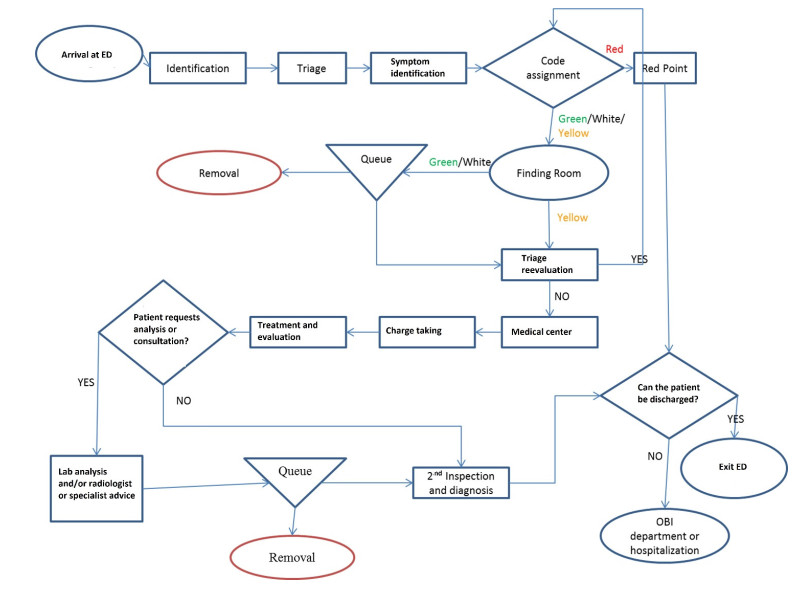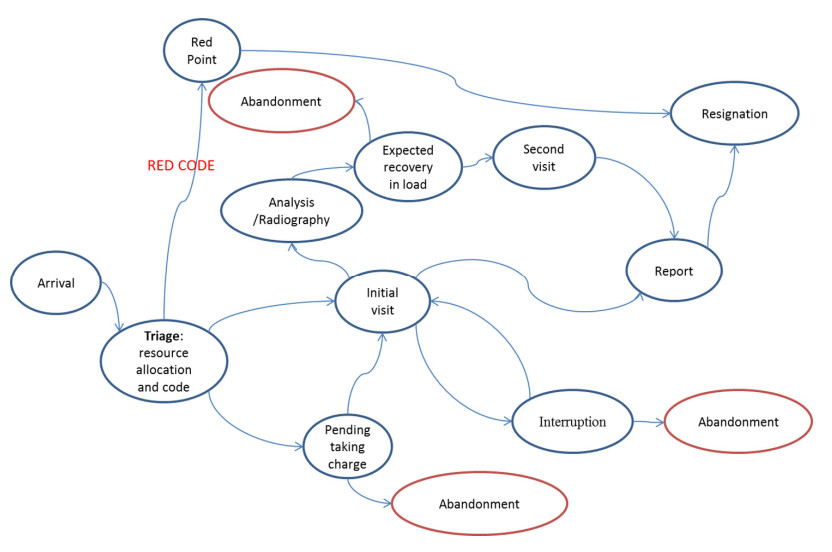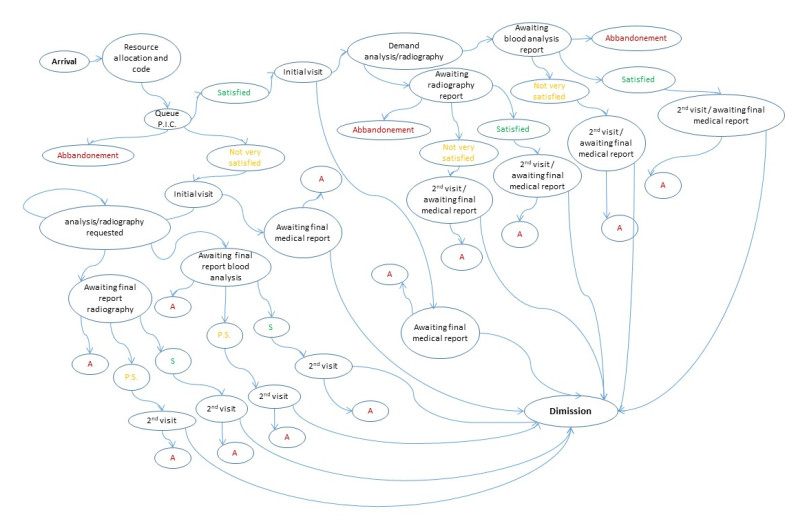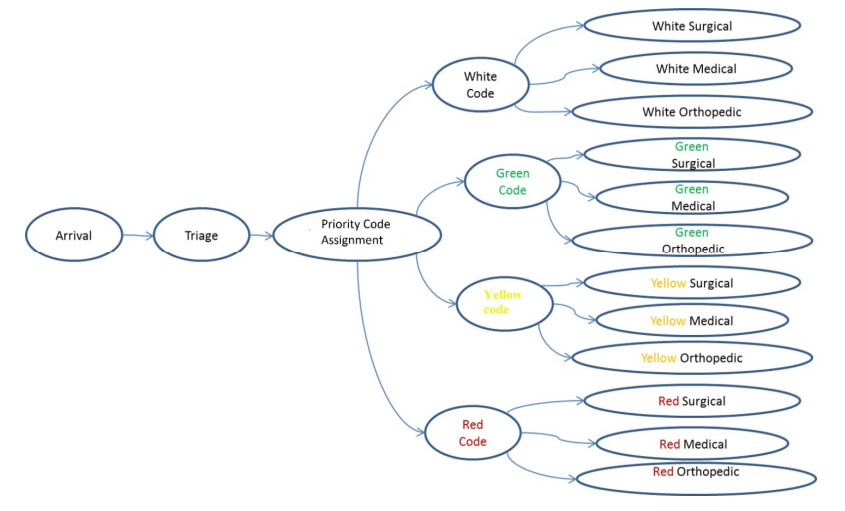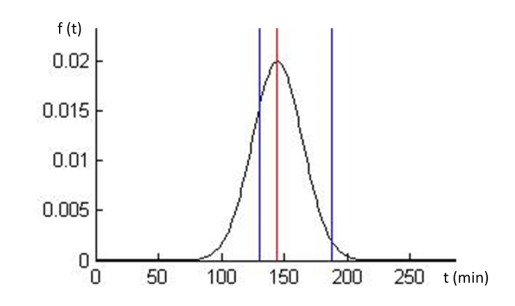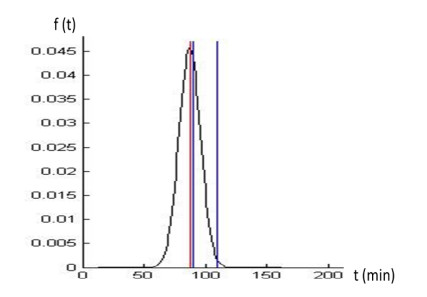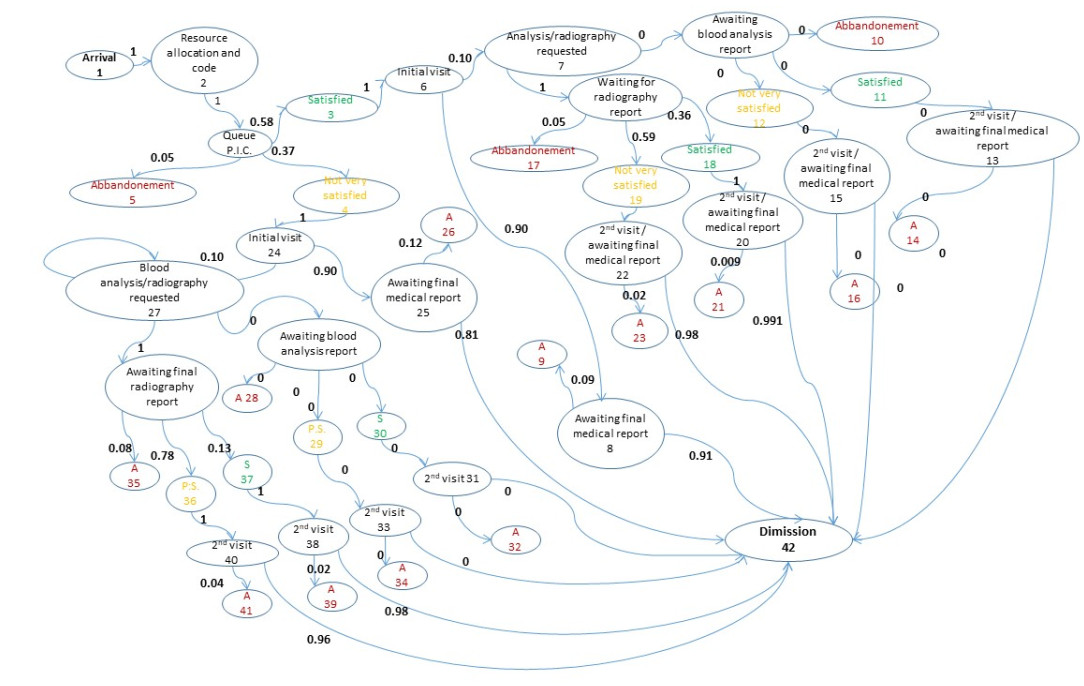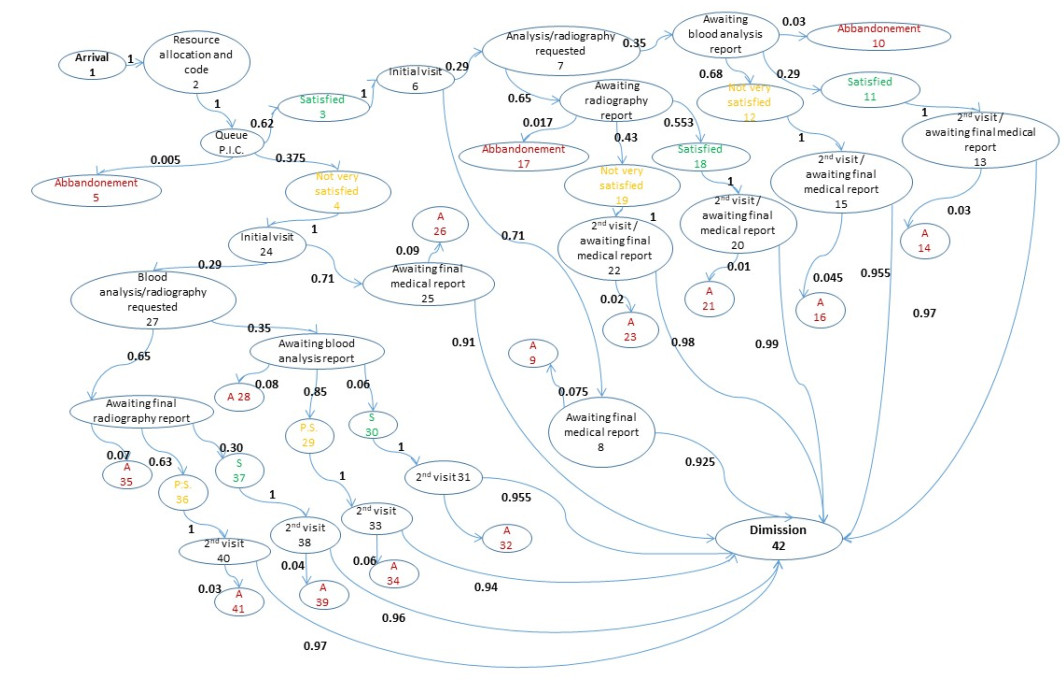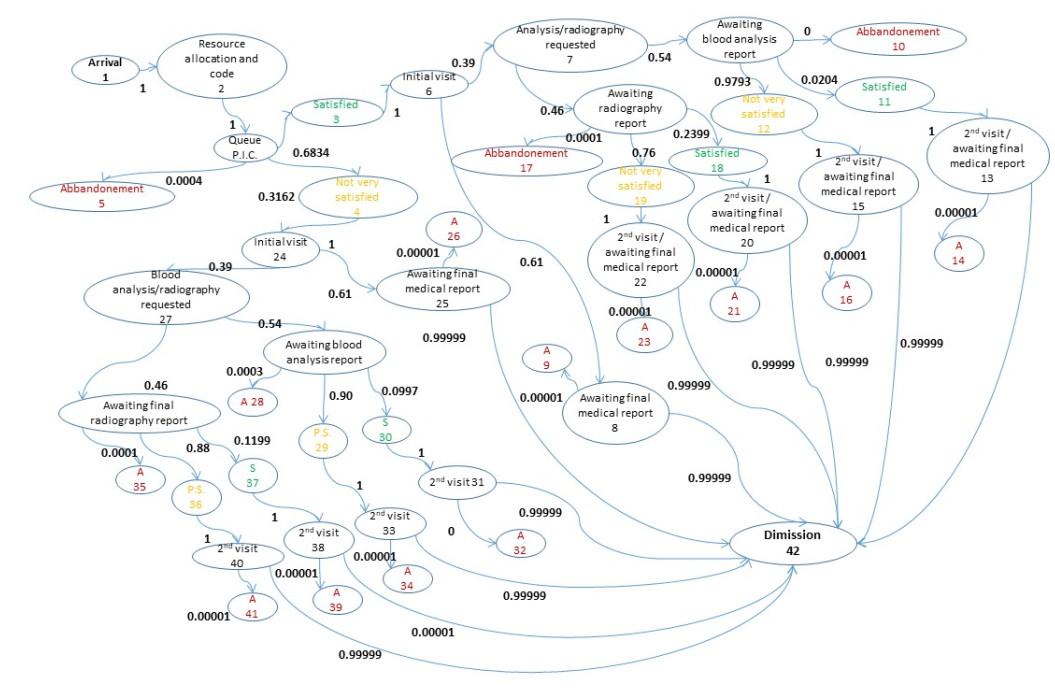In the literature, several organizational solutions have been proposed for determining the probability of voluntary patient discharge from the emergency department. Here, the issue of self-discharge is analyzed by Markov theory-based modeling, an innovative approach diffusely applied in the healthcare field in recent years. The aim of this work is to propose a new method for calculating the rate of voluntary discharge by defining a generic model to describe the process of first aid using a "behavioral" Markov chain model, a new approach that takes into account the satisfaction of the patient. The proposed model is then implemented in MATLAB and validated with a real case study from the hospital "A. Cardarelli" of Naples. It is found that most of the risk of self-discharge occurs during the wait time before the patient is seen and during the wait time for the final report; usually, once the analysis is requested, the patient, although not very satisfied, is willing to wait longer for the results. The model allows the description of the first aid process from the perspective of the patient. The presented model is generic and can be adapted to each hospital facility by changing only the transition probabilities between states.
1.
Introduction
In general, one of the criteria for measuring economic growth is the real GDP per capita (RGDPPC) of a country. The discussion on the nature of economic variability always remains a hot topic at the center of macroeconomic research. An important issue is whether the business cycle is exclusively transitory or whether it is considered mostly by permanent rather than temporary shifts. Albeit, there is a conventional wisdom of the business cycle that hypothesizes that GDP growth rate fluctuations are perpetual deviations from trend. It requires employing macroeconomic stabilization strategy encompassing both monetary and fiscal policies to manage with GDP disturbance as put forward by Keynes arguing neoclassical macroeconomic view. The RGDPPC is one of the most critical signs of the affluence of nations. Therefore, it is crucial to determine whether the per capita income follows a trend stationary or a difference stationary process1.
1Zeren and İşlek (2019).
Lucas (1977) mentions with the question, "Why is it that, in capitalist economies, aggregate variables undergo repeated fluctuations about trend, all of essentially the same character?" Similarly, Nelson and Plosser (1982) on the investigation of the time-series properties of real output levels reveal that "we are unable to reject the hypothesis that these series are non-stationary stochastic processes with no tendency to return to a trend line. Based on these findings and an unobserved components model for output that decomposes fluctuations into a secular or growth component and a cyclical component, we infer that shocks to the former, which we associate with real disturbances, contribute substantially to the variation in observed output". After the influential work of Nelson and Plosser (1982), several other studies examine the potential time-series properties of crucial macroeconomic variables. Nelson and Plosser expound that a unit root in real output is uneven with the belief that business cycles are stationary variations all over a deterministic trend. Many prior studies including Perron (1988) endorse the findings of Nelson and Plosser (1982).
In a similar vein, Campbell and Mankiw (1987) summarize that as per the conventional view of the business cycle, fluctuations in output characterize transitory deviations from the trend. The empirical findings reveal a natural complement to standard tests of non-stationarity, while, using quarterly postwar US data. The study further adds that several business cycles' traditional theories sustain two simple ideas. First, fluctuations in output are supposed to be determined mainly by shocks to aggregate demand, like fiscal and monetary policies, or animal spirits. Second, shocks to aggregate demand are supposed to have merely a transitory influence on output; the economy returns to the natural rate in the long run. Li (2000) notes the rational implication of the government set off structural reform would certainly be of limited value if real output holds a unit root. Smyth and Inder (2004) using RGDPPC find a unit root for the majority of provinces of China. The study suggests that the government launched structural reform will be offset by other shocks, limiting its effects on the long-run growth track for all these provinces in China.
To examine empirically the time-series properties of output, cross-sectional and panel data analysis have been carried out by several existing studies for different countries using different sample periods. Where visible criticism of unit root tests has been observed, notably the Augmented Dickey-Fuller (ADF) test due to its low power against substantial, but stationary replacements with generally existing time lengths of data. While some researchers are in favor of the panel unit root techniques because of having more power as compared to unit root tests designed for univariate time series2. However, every country indeed has its own administrative, cultural, economic, political and social characteristics; therefore, time series analysis has its own undeniable features over the other one. Thus, the primary purpose of the present study is to empirically investigate the stationarity property of output fluctuations for a set of 177 countries from the whole World over the period ranging from 1960 to 2018. The critical feature of this study is that, to the best of the authors' knowledge, the research in hand is the first of its kind to employ the newly developed wavelet unit root tests proposed by Aydin and Pata (2020)3. These tests are developed in the wavelet framework that takes into account both frequency as well as time dimensions and also considers the issue of smooth structural break(s), thus it provides more robust inferences as compared to existing wavelet unit root tests such as Fan and Gencay (2010) which have low power particularly under negative moving averages and also when there are structural break(s) (see Eroglu and Soybilgen (2018) for more details). The wavelet tests proposed by Aydin and Pata (2020) are the wavelet version of popular Augmented Dickey Fuller (ADF) tests and named as Wavelet ADF (WADF) and its Fourier version—the Fourier WADF (FWADF) which considers the frequency dimension as well and which has the ability to take into account any smooth structural break(s). Thus, this study makes use of these recently developed WADF and FWADF by Aydin and Pata (2020). Further, this is the first study, using the maximum available numbers of countries along with a considerable length of the time period (minimum 25 years of annual observations), particularly, countries from all seven regions (East Asia and Pacific, Europe and Central Asia, Latin America and the Caribbean, Middle East and North Africa, North America, South Asia and Sub-Saharan Africa) across the globe are selected and analyzed. Therefore, the present study contributes significantly to the literature on the investigation of time series properties of per capita GDP for almost the entire World economies with more holistic empirical techniques.
2Banerjee et al (2005).
3See also Aydin (2019).
Note that the the categorization of countries on the basis of geographical location is done to make the presentation of results more convenient and presentable. Previous, several studies on the energy-growth nexus, have adopted a similar approach and analyzed the nexus by considering different regions across the globe. See for example, Apergis and Payne (2009) for Central America; Eggoh et al. (2011) for African countries; Noor and Siddiqi (2010) for South Aisan countries; Jalil (2014) for net energy exporter and importer countries; Ozturk (2010) for a survey of studies on several geographical locations; Tiba and Omri (2017) for a survey of studies on energy, environment and economic growth; Rodríguez-Caballero and Ventosa-Santaulària (2017) for Latin American economies; Rodríguez-Caballero (2021) for four different regions, Asia and Pacific, Europe, Africa, The Americas. All these studies make use of conventional unit root tests (considering time dimension only) to assess the stationarity of the chosen data series as part of their empirical analysis. However, as highlighted in Aydin and Pata (2020) and the findings of current study show that ignoring the frequency dimension while applying unit root test may lead to misleading inferences regarding the stationarity of series under examination. So, one may re-assess the claims made by these studies by following our approach which provides better insights, as it not only takes into account the time dimension but also the frequency dimension as well along with (any) smooth structural change. Note that, the above studies are taken from energy-growth literature, however, there are several other studies, where real GDP per capita (RGDPPC) series is considered and its nexus is considered with other potential (macroeconomic) time series, and stationarity of RGDPPC is established using conventional (time domain based) unit root tests as part of their empirical analysis, so their results should also be re-analyzed and updated under the light of empirical findings presented in our study.
The remainder of the study is structured as follows. Section 2 deals with the literature review of the research. Section 3 introduces the econometric methodology used. Section 4 interprets the empirical findings while Section 5 concludes the study.
2.
Literature review
The available literature provides much empirical evidence on the investigation of time-series properties of macroeconomic variable namely per capita GDP or GDP or Gross National Product GNP (real). However, the empirical results of these previous studies are yet elusive. For example, Nelson and Plosser (1982) find that US real GDP to be a non-stationary process using annual data, mostly averages for the year, with a start from 1860–1909 and ending in 1970 in all cases. Campbell and Mankiw (1987) reveal regarding short-run dynamics that make GNP divergent from a random walk with drift. The long-run implications of the study estimates indicate that shocks to GNP are mostly permanent. Haan and Zelhorst (1993) observe that the traditional unit root tests fail to discard the null hypothesis of a unit root which exhibits stationarity of output in 12 OECD countries with the exception of US. Similarly, Li (2000) shows that China's output series is trend stationary while employing unit root tests with structural breaks for the empirical analysis carried over the period 1952 to 1998.
Chang et al. (2005) intensely reject the null of unit root process for one-third in 26 African countries during 1960–2000. Based on the empirical results, their study suggests that fiscal and/or monetary policies are expected to have only provisional impacts on the real output levels of over one-third out of 26 African countries. Narayan (2007) rejects the unit root null hypothesis for G7 countries at the 5% level except for Germany and Italy, over the period from 1870–2001, while employed Lagrange Multiplier test. In a similar vein, Narayan (2008) investigates whether GDP per capita for 15 Asian countries is panel stationary. The study indicates prodigious evidence of panel stationarity of real GDP per capita for different panels in the context of Asian countries. The empirical findings of Chen (2008) favor the view that the real GDP per capita of six countries namely Australia, France, Germany, Japan, UK and USA is illustrated by a stationary process when making use of one-break unit root test. However, the study rejects the null of unit root for 11 of 19 developed countries' real GDP per capita when employed the two-break unit root test. Thus, it suggests that results are reliable with the view that business cycles show stationary fluctuations around a deterministic trend. Chang et al. (2010) empirical results direly reject the unit root process for most of the Chinese provinces during 1952–1998 while the null doesn't get rejected for 11 out of 25 provinces.
Cuestas and Garratt (2011) observe evidence of a worldwide stationary ESTAR process around a nonlinear deterministic trend in more or less half of the studied countries. The study further adds that our findings reveal that nonlinearities act on real GDP series, while abandoning them; one can reach to ambiguous conclusions from unit root tests. Chang et al. (2011) confirm that real GDP is well exemplified by a non-linear mean returning process in three out of nine Central Eastern European (CEE) countries namely Bulgaria, Latvia and Romania during 1969–2009. Tiwari et al. (2012a) investigate stationarity properties of GDP per capita for 17 Asian countries4 and sub-panels during 1950–2009. The empirical results of the second-generation tests for unit root show stationarity of GDP per capita for the whole Asian panel and even for the East Asian and high-income Asian sub-panels as well. However, in the case of sub-panel for the South Asia, the study provides a weak indication for stationarity of GDP per capita. While, in another study by Tiwari et al. (2012b), the results show that real GDP per capita is nonlinear stationary indicating that shocks to economy by external or internal policies have lasting influence on real per capita GDP of SAARC countries during 1980–2010. Shen et al. (2013) find that a real shock would be lastingly affect the real per capita real GDP of three CEE countries namely, Bulgaria, Hungary and Poland during 1991–2012. The empirical evidence supports the real shocks which have a transitory influence on the long-run output levels, implying in these six CEE countries that their real GDP per capita settlement is a mean reversion in the direction of equilibrium values which shows periods of exploding behavior. The study further maintains that real GDP per capita follows a steady growth rate where policy implications then have transitory influences in the case of 6 CEE countries (i.e., Czech Republic, Estonia, Latvia, Lithuania, Romania, and Slovakia).
4Countries includes Bangladesh, Cambodia, China, Hong Kong, India, Indonesia, Japan, Malaysia, Myanmar, Pakistan, Philippines, Singapore, South Korea, Sri Lanka, Taiwan, Thailand, and Vietnam.
The findings of Jannati et al. (2013) reveal that the real GDP per capita over the period 1970–2009 in 5 countries is stationary while carrying out empirical analysis of 16 countries in Asia with non-linear approaches to test for stationarity. Dogru (2014) evaluates the stationarity property of real GDP per capita fluctuations for a panel of 11 MENA countries during 1970–2012. The empirical results of both seemingly unrealated ADF (SURADF) and cross-sectional ADF (CADF) approaches lead support to stationarity of real GDP per capita. The study demonstrates that the shocks to the output are mostly lasting rather than temporary. The empirical findings of Chang et al. (2014) from numerous conventional unit root tests validate that real GDP per capita for 52 African countries is non-stationary, while, when the SPSM using the Panel KSS unit root test with a Fourier function is employed, the study observes that real GDP per capita are stationary in 50 out of 52 selected countries. The empirical outcomes suggest that real GDP per capita fluctuations for these countries are inclusively transitory during 1969v2011. Using the BCIPS panel unit root test by Zeren and İşlek (2019) in the case of D8 economies from 1960–2014 reveal that GDP per capita is stationary in multifactor situations in chosen D8 economies. Using Box-Jenkins approach (known as ARIMA), Nyoni and Muchingami (2019) suggest that Botswana GDP per capita is not mean reverting over the period 1960–2017 with stable estimates, indicating that in next few years, the overall standard of life will for Botswanian people will improve.
Table 1 portrays the summary of erstwhile empirical work available analyzing the stationarity property of output fluctuations. The forgoing analysis demonstrates that evidently the empirical results are inconclusive and still the stationarity property of output fluctuations is unsolved and further research on the topic under the study is required.
5Enders and Lee (2012).
61st and 2nd generation panel unit root tests respectively are those proposed in Levin et al (2002), Im and Shin (2003), Maddala and Wu (1999); Pesaran (2007) and Choi (2006).
3.
Econometric approach and data
3.1. Econometric approach
This paper makes use of recently developed unit root tests developed by Aydin and Pata (2020) based on a general wavelet spectral approach. Working in parallel to Aydin and Pata (2020) and Yazgan and Ozkan (2015), the following DGP is considered which takes into account the smooth structural change as well: xt=γ(t)+ϵt
where, γ(t) is unknown deterministic component (Becker et al., 2006), given by:
Note that "k" and "n" respectively denotes frequency of fourier term and deterministic component and when n = 1, the series contains a smooth break and when n > 1, break becomes more sharp and abrupt (see Aydin and Pata (2020) and Yazgan and Ozkan (2015) for more details). The case of smooth break (n = 1) is considered by Aydin and Pata (2020) by using the Wavelet ADF (WADF) test by Eroglu and Soybiligen (2018). The same is considered in this study and is given below:
where, Y1,t indicates scaling coefficients that show low frequency components obtained via wavelet filter (we used Haar filter, which according to Aydin and Pata (2020) is powerful). The focus is made on testing the following null and alternative hypotheses:
H0: τ = 0 (unit root) against H1: τ < 0 (no unit root)
The null is tested via standard ADF statistic:
where, ˆτ and SE(ˆτ) are the estimate of τ and its corresponding standard error.
To carryout FWADF unit root test, a two-step procedure suggested in Enders and Lee (2012) is adopted, where, model in Equation (2) is estimated for different frequencies, k = 1, 2, …, 5., and residuals sum of squares (RSS) is calculated for each model and then a model is selected among all these candidate models which RSS. In the next step, a standard t-test is applied to has lowest value of assess non-linearity and if fourier term in Equation (2) is found to be insignificant then WADF unit root test is applied, and in case of significant fourier term, the FWADF unit root test is applied. The critical values are obtained by following guidelines in Becker et al. (2006) and the same are provided in Table 10 (A–C) in Supplementary for different sample sizes that we considered in this study.
3.2. Data and its sources
We use annual time series data on real GDP per capita of all countries across the world. It is measured in constant 2010 US dollars. The data source is WDI 2020, the World Bank database. The total number of countries selected for the analysis are 177 out of a total available 218 countries on WDI. For the remaining 41 countries, either the data was not available at WDI or the data span was less than 25 years. We set minimum limit to 25 data points to get reasonable power of the wavelet tests considered in this study even under small samples. The countries are classified into seven different regions (East Asia and Pacific Region, Europe and Central Asia, Latin America and the Caribbean, Middle East and North Africa, North America, South Asia and Sub-Saharan Africa) as per guidelines of World Bank. Note that the idea of classifying countries is not necessary, however, this is done to present the empirical results in a more meaningful way as most of the time, the empirical researchers are interested in carrying out analysis by considering a particular region. The same countries can be sub categorized as per different income groups as well, but we thought it better to present the analysis region-wise as this will give us deep insights of the issue at hand and it will portray a clear picture for different regions of the world which is currently not available anywhere in the existing literature. The time period for most of the countries is 1960 to 2018, while for some countries, we use a different time period to make use of maximum available data for the analysis of chosen countries. The names of countries along with their three-digit code as per WDI guidelines and the selected time period is provided in each table for clarity. The results of basic summary statistics are calculated but are not reported here to save space but these are available from authors upon request.
4.
Empirical findings and discussions
This section provides results of wavelet-based unit root tests—the WADF and FWADF. Please note that as per World Bank, the total number of countries included in East Asia and Pacific Region are 38. Among these 38 countries, we are able to get data of 26 of them with at-least 25 observations, and carried out analysis for these 26 countries reported in Table 2. The empirical findings reveal useful insights of the behavior of the time series under consideration. Specifically, only one country, Brunei Darussalam is found to be stationary under both specifications (constant as well as constant and trend) while for 4 out of 26 countries (Brunei Darussalam, Vanuatu, Samoa and Cambodia), the null of non-stationarity gets rejected under constant and trend specification and for 3 out of 26 countries (Japan, Micronesia Fed. Sts. and Brunei Darussalam), null gets rejected under only constant specification. Overall, for 6 countries (Japan, Micronesia Fed. Sts., Vanuatu, Samoa, Cambodia and Brunei Darussalam), the null of unit root gets rejected under any of the two specifications (with constant and constant plus trend) considered. So in total, out of 26 countries, the null hypothesis that the series has a unit root gets rejected by 6 countries while for the rest of 20 countries, the series is found to be stationary and null couldn't get rejected by the wavelet tests considered.
The results related to countries included in Europe and Central Asia are provided in Table 3. According to guidelines by World Bank, the total number of categories in this region are 58. From these 58 countries, we are able to get data of 46 of them with at-least 25 observations, and carried out analysis for these 46 countries. The empirical findings reveal useful insights of the behavior of the time series under consideration. Specifically, in case of model with constant specification, 7 out of 46 countries namely, France, Greece, Georgia, Tajikistan, Ukraine, Russian Federation and Belarus are found to be stationary while rest of 39 countries have non-stationary per capita GDP, and when the constant and trend specification is considered, 21 countries out of 46, namely, Spain, Finland, Greece, Iceland, Norway, Andorra, Albania, Tajikistan, Kyrgyz Republic, Ukraine, Azerbaijan, Czech Republic, Kazakhstan, North Macedonia, Romania, Slovenia, Hungary, Slovak Republic, Bosnia and Herzegovina and Serbia are found to be stationary while rest of 25 countries have non-stationary per capita GDP and for three countries (Greece, Tajikistan and Ukraine), the null of unit root gets rejected under both specifications considered (constant and constant plus trend), while for 25 countries the null gets rejected under any of the two specifications considered. So in total, out of 46 countries, the null hypothesis that the series has a unit root gets rejected by 25 countries while for the rest of 21 countries, the series is found to be stationary and null couldn't get rejected by any of the specifications considered.
The empirial results for the Latin America and the Caribbean region are presented in Table 4 and as per World Bank, this region constitutes of a total of 42 countries. We were lucky to obtain data on 36 countries comprising of at-least 25 annual observations and thus, the empirical analysis is done for the 36 countries. The empirical findings provide detailed analysis of data series considered. Specifically, considering the model with constant specification, 7 out of 36 countries, namely, Bahamas, Suriname, Venezuela RB, Jamaica, Barbados, Dominica and Aruba are found to have a stationary per capita GDP, while rest of 29 countries have non-stationary per capita GDP, and in case of model with constant and trend specification, 12 countries out of 36, namely, Bahamas, Belize, Brazil, Ecuador, Guatemala, Suriname, Trinidad and Tobago, Venezuela RB, Jamaica, Switzerland, Grenada and Aruba are found to have stationary per capita GDP, while rest of the 19 countries have non-stationary per capita GDP. In addition, 5 countries (Bahamas, Suriname, Venezuela RB, Jamaica and Aruba) have stationary per capita GDP under both specifications, while 14 out of selected 46, have per capita GDP stationary under either of the two specifications. These include, Bahamas, Belize, Brazil, Ecuador, Guatemala, Suriname, Trinidad and Tobago, Venezuela RB, Jamaica, Switzerland, Barbados, Dominica, Grenada and Aruba. So in total, out of 36 countries, the null hypothesis that the series has a unit root gets rejected by 14 countries while for the rest of 22 countries the series is found to be non-stationary and null couldn't get rejected by any of the tests considered.
Table 5 provides the findings of unit root tests for the Middle East and North African region which comprises of 21 countries in total (as per World Bank). A careful inspection yields data on 17 out of 21 countries with a minimum of 25 years of span. Thus, the sample for this group comprises of 17 countries. The empirical results are interesting in the sense that for the model with constant specification, 7 out of 17 countries, namely, Iran, Islamic Rep., Oman, Saudi Arabia, United Arab Emirates, Jordan, Bahrain and Lebanon are found to have a stationary series for per capita GDP, while the rest of 10 countries have non-stationary per capita GDP, similarly, for the model with constant and trend specification, 9 countries out of 17 considered, namely, Algeria, Egypt, Israel, Malta, United Arab Emirates, Jordan, Bahrain, Lebanon and West Bank & Gaza are found to be stationary while rest of 8 countries have non-stationary per capita GDP. In addition, 4 countries (United Arab Emirates, Jordan, Bahrain and Lebanon) have stationary per capita GDP under both specifications, while 12 out of selected 17, have per capita GDP stationary under either of the two specifications. So in total, out of 17 countries, the null hypothesis that the series has a unit root gets rejected by 12 countries while for the rest of 5 countries, the series is found to be non-stationary and null couldn't get rejected under any of the two specifications considered.
The North American region includes only three countries and all three have been considered in this study due to availability of relevant data. The results for these countries are provided in Table 6. The results suggest that for the model with constant specification, none of the three selected countries has stationary per capita GDP i.e., all countries have non-stationary per capita GDP, while, for the model with constant and trend specification, only one country (Bermuda) out of three, has stationary per capita GDP while the other two Canada and United States have non-stationary per capita GDP and none of the selected countries is found to be stationary under both specifications (constant as well as constant and trend), while only one country (Bermuda) is considered stationary under either of the two specifications. So for all the countries included in North America region, the GDP per capita series is found to be trend stationary and its in case of Bermuda only.
The total number of countries in South Asia is eight. A total of 6 countries were able to meet the goal of containing a minimum of 25 years of data, so these countries are sorted for this region and final analysis is carried out for these and is presented in Table 7. The empirical findings suggest that under constant specification, the per capita GDP of all 6 selected countries is found to be stationary, while, under constant and trend specification, the per capita GDP of 5 out of 6 selected countries is found to be stationary. In addition, none of the selected countries is found to be stationary under both specifications while only one is considered stationary under either of the two specifications. Thus, out of 6 countries, the null hypothesis that the series has a unit root gets rejected by only one country, while for the rest of 5 countries the series is found to be stationary and null couldn't be rejected under any of the two specifications considered.
There are 48 countries in the Sub-Saharan Africa region (as per World Bank). A sample of 43 is finalized after removing the countries that had fewer number of observations, fewer than 25 (the set limit). The empirical results presented in Table 8 reveal that for the model under constant specification, 6 out of 43 countries, namely, Niger, Togo, Zambia, Zimbabwe, Guinea-Bissau and Equatorial Guinea are found to be stationary while rest of 37 countries have non-stationary per capita GDP, while for the model with constant and trend specification, 7 countries out of 43, namely, Botswana, Central African Republic, Cameroon, Zimbabwe, Gambia, Equatorial Guinea and Tanzania are found to be stationary while rest of 36 countries have non-stationary per capita GDP. In addition, 2 countries (Zimbabwe and Equatorial Guinea) have stationary per capita GDP under both specifications, while 11 out of selected 43 countries, have per capita GDP stationary under either of the two specifications. Overall, out of 43 selected countries, the null hypothesis of unit root gets rejected by 11 countries while for the remaining 32 countries we find evidence in favor of null under any of the two specifications considered.
In addition to the results presented in Table 2–8, the overall summary of these empirical results is presented in Table 9 to get a quick idea of the key results. These results exhibit that out of a total of 218 countries, 177 were selected for the analysis with at-least 25 years of available data and out of these 177 countries, the per capita GDP series is found to be stationary for 70, while for the rest of 107 countries it is found to be non-stationary. To get a summary containing exact names of countries for which per capita GDP is stationary, the findings are presented in the form of a bar graph (Figure 1), where a bar of unit length against a country is added, indicating the rejection of null of unit root. The empirical estimates related to stationarity of real GDP per capita income in 70 countries of this study are consistent with the findings by Narayan (2004), Murthy and Anoruo (2009), Ying et al. (2013) and Baktemur (2019), while results of non-stationarity of GDP per capita in 107 countries are in accord with Rapach (2002), Ozturk and Kalyoncu (2007), Aslanidis and Fountas (2014), Firat (2016), and Oskooe and Akbari (2015). Overall results are consistent with the findings by Smyth (2003), Chang et al.(2005, 2006), Tiwari and Suresh (2014), Emirmahmutoglu et al. (2019).
An important distinction of the empirical results presented in this study from the existing studies is that the tests used in present study makes use of both frequency and time dimensions into account which is ignored by all previous studies. As emphasized in Aydin and Pata (2020), ignoring information regarding frequency domain and structural change may lead to biased results. Thus, the findings presented in present study are more complete and robust and provide a better picture of the issue at hand which his ignored by previous studies considering the same issue and hence, the present study fills this much needed gap.
5.
Summary and conclusions
The role of GDP per capita cannot be overlooked measuring socio-economic status of individual and country's economic condition. Policy makers usually need stationary time series data for modeling and forecasting. They avoid using non-stationary data which are changeable and cannot be used for modeling and forecasting due to its erratic (unstable) behavior. The empirical findings derived using non-stationary time series data may be forged. The non-stationary data may be converted in to stationary data which yields more reliable, consistent results. Therefore, it is indispensable to determine whether the GDP per capita income has a trend stationary or a difference stationary process. Thus, the broad aim this study is to evaluate the stationarity properties of GDP per capita for a panel of 177 out of total 218 countries over 1960–2018 with at-least 25 years of available annual data, considering seven sub-samples (regions) categorized by world bank. We utilized historical, longer period updated data, and covered the entire world which is never evaluated by any of erstwhile studies before. We implemented the newly developed unit root tests (WADF and FWADF) by Pata and Aydin (2020) based on discrete wavelet transform to analyze the stationarity properties. An important advantage of these wavelet unit root tests is that these have the ability to consider the smooth structural break into account which is not considered by any of the previous existing wavelet tests such as the one proposed by Fan and Gencay (2010). Thus, the empirical results presented in this study are better than existing approaches and provide new insight of long-standing issue of testing the stationarity of per capita GDP series across the globe.
The empirical estimates reveal that GDP per capita is found to be stationary in 70 including 6 out of 26 East Asia and Pacific countries, 25 out of 46 Europe and Central Asian countries, 14 out of 36 Latin America and the Caribbean countries, 12 out of 17 Middle East and North African countries, 1 out of 3 three selected countries in North America, 1 out of 6 South Asian countries and 11 out of 43 countries in Sub-Saharan Africa, while for the rest of 107 countries, the real GDP per capita is found to be non-stationary. It is obvious from the empirical findings that GDP per capita income is stationary in several countries. The stationary time series of per capita GDP is desirable for any public policy across the world, where as the non-stationary GDP per capita needs to be transformed into stationary data in order to avoid inconsistency in the data. These findings suggest that it is imperative for policy makers to check the stationary properties of real GDP per capita series prior to utilizing it for any policy formulation using the empirical approaches used in this study which not only considers both freqency and time domain into account but also smooth structural changes as well.
Acknowledgements
This research did not receive any specific grant from funding agencies in the public, commercial, or not-for-profit sectors. The authors thank Mucahit Aydin for sharing replication codes.
Conflicts of interest
All authors declare no conflicts of interest in this paper.









 DownLoad:
DownLoad:



